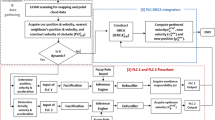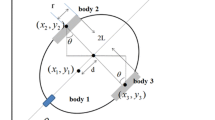Abstract
Different from ordinary mobile robots used in a well-structured industrial workspace, a guide mobile robot for the visually impaired should be designed in consideration of multiple moving obstacles of various types and with different speeds while it adaptively maintains a certain distance from the user. Here, the moving obstacles mostly refer to pedestrians in intentional motions. Thus, navigation of the guide robot can be facilitated if the intention of each obstacle detected can be known in advance.
In the paper, we propose to use a fuzzy grid-type local map in order to infer the intention of a moving obstacle. And, then, we determine the motion control of the robot by adopting a multiobjective decision making method in order to take into consideration various requirements including goal-seeking, multiple obstacle avoidance and maintenance of a certain distance from the user. To show the effectiveness of the proposed method, some experimental results are provided.
Similar content being viewed by others
References
Alwan, M. and Cheung, P.Y.K. 1997. Modelling and handling uncertainties in mobile robotics. J. of Intelligent and Fuzzy Systems, 5:205-217.
Anderson, T.L. and Donath, M. 1990. Autonomous robots and emergent behavior: A set of primitive behaviors for mobile robot control. In Proceedings of IEEE Int. Workshop on Intelligent Robots and Systems, Tsuchiura, Japan, pp. 723-730.
Beom, H.R. and Cho, H.S. 1995. A sensor-based navigation for a mobile robot using fuzzy logic and reinforcement learning. IEEE Transactions on Systems, Man, and Cybernetics, 25(3):464-477.
Borenstein, J. and Ulrich, I. 1997. The guidecane-A computerized travel aid for the active guidance of blind pedestrians. In Proceedings of IEEE Int. Conf. Robotics and Automation, Albuquerque, NM, pp. 1283-1288.
Brooks, R. 1986. A robust layered control system for a mobile robot. IEEE J. Rob. & Aut, RA-2(1):14-22.
Clark-Carter, D.D., Heyes, A.D., and Howarth, C.I. 1986. The efficiency and walking speed of visually impaired people. Ergonomics, 29(12):1575-1581.
D'Andrea-Novel, B., Bastin, G., and Campion, G. 1992. Dynamic feedback linearization of nonholonomic wheeled mobile robots. In Proceedings of IEEE Int. Conf. Robotics and Automation, Nice, France, pp. 2527-2532.
Ejir, M. 1996. Towards meaningful robotics for the future: Are we headed in the right direction. Robotics and Autonomous Systems, 18:1-5.
Fujimura, K. 1996. Path planning with multiple objectives. IEEE Robotics & Automation Magazine, 3(1):33-38.
Ifukube, T., Sasaki, T., and Peng, C. 1991. A blind mobility aid modeled after echolocation of bats. IEEE Trans. Biomedical Engineering, BME-38(5):461-465.
Kim, K. and Kim, J. 1994. Multicriteria fuzzy control. Journal of Intelligent and Fuzzy Systems, 2:279-288.
Kim, S.H., Lee, H., and Bien, Z. 1999. Obstacle's intention inference using the grid-type map. In the Institute of Electronics Engineering of Korea Summer Conference 99, Seoul, Korea, pp. 796-804.
Kuc, R. and Viard, V.B. 1991. A physically based navigation strategy for sonar-guided vehicles. International Journal of Robotics Research, 10(2):75-87.
Lai, Y. and Hwang, C. 1996. Fuzzy Multiple Objective Decision Making, Springer-Verlag: Berlin.
Lim, T. and Bien, Z. 1996. FLC design for multi-objective system. International Journal of Applied Mathematics and Computer Science, 6(3):565-580.
Lozano-Perez, T. 1983. Spatial planning: A configuration space Approach. IEEE Trans. On Computer, C-32(2):108-120.
MacNamara, S. and Lacey, G. 1999. A robotic mobility aid for frail visually impaired people. In Proceedings of Int. Conf. Rehabilitation Robotics, Stanford, CA, pp. 163-169.
Makoto, F. and Fuhashi, T. 1999. A proposal of extraction of intentions in linguistic instructions using fuzzy classifier. Journal of Japan Society for Fuzzy Theory and Systems, 11(1):92-98.
Mitchell, J.S.B. 1988. An algorithmic approach to some problems in terrain navigation. Artificial Intelligence, 37:171-201.
Moravec, H.P. and Elfes, A.E. 1985. High resolution maps from wide angle sonar. In IEEE International Conference of Robotics and Automation, St. Louis, pp. 116-121.
Oriolo, G., Ulivi, G., and Vendittelli, M. 1998. Real-time map building and navigation for autonomous robots in unknown environments. IEEE Trans. On SMC(B), 28(3):316-333.
Reinfrank, M., Hellendoorn, H., and Driankov, D. 1993. An Introduction to Fuzzy Control, Springer-Verlag: Berlin.
Shoval, S., Borenstein, J., and Koren, Y. 1998. Auditory guidance with the navbelt-A computerized travel aid for the blind. IEEE Transactions on Systems, Man, and Cybernetics, 28(3):459-467.
Tachi, S., Mann, R.W., and Rowell, D.R. 1983. Quantitative comparison of alternative sensory displays for mobility aids for the blind. IEEE Trans. Biomedical Engineering, BME-30(9):571-577.
Tachi, S., Tanie, K., Komoriya, K., and Abe, M. 1985. Electro-cutaneous communication in a guid dog robot(MELDOG). IEEE Trans. Biomedical Engineering, BME-32(7):461-469.
Ulrich, I. and Borenstein, J. 1998. VFHC: Reliable obstacle avoidance for fast mobile robots. In Proceedings of IEEE International Conference of Robotics and Autonomous, Leuven, Belgium, pp. 90-98.
Zimmermann, H.-J. 1985. Fuzzy Set Theory and its Applications, Kluwer: Dordrecht.
Author information
Authors and Affiliations
Rights and permissions
About this article
Cite this article
Kang, DO., Kim, SH., Lee, H. et al. Multiobjective Navigation of a Guide Mobile Robot for the Visually Impaired Based on Intention Inference of Obstacles. Autonomous Robots 10, 213–230 (2001). https://doi.org/10.1023/A:1008990105090
Issue Date:
DOI: https://doi.org/10.1023/A:1008990105090




